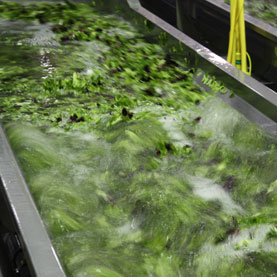In the on-going discussion of whether dangerous pathogens can be internalized in leafy greens, Erickson, et al. write:
Preharvest internalization of Escherichia coli O157:H7 into the roots of leafy greens is a food safety risk because the pathogen may be systemically transported to edible portions of the plant. In this study, both abiotic (degree of soil moisture) and biotic (E. coli O157:H7 exposure, presence of Shiga toxin genes, and type of leafy green) factors were examined to determine their potential effects on pathogen internalization into roots of leafy greens.
 Using field soil that should have an active indigenous microbial community, internalized populations in lettuce roots were 0.8 to 1.6 log CFU/g after exposure to soil containing E. coli O157:H7 at 5.6 to 6.1 log CFU/g. Internalization of E. coli O157:H7 into leafy green plant roots was higher when E. coli O157:H7 populations in soil were increased to 7 or 8 log CFU/g or when the soil was saturated with water. No differences were noted in the extent to which internalization of E. coli O157:H7 occurred in spinach, lettuce, or parsley roots; however, in saturated soil, maximum levels in parsley occurred later than did those in spinach or lettuce. Translocation of E. coli O157:H7 from roots to leaves was rare; therefore, decreases observed in root populations over time were likely the result of inactivation within the plant tissue.
Using field soil that should have an active indigenous microbial community, internalized populations in lettuce roots were 0.8 to 1.6 log CFU/g after exposure to soil containing E. coli O157:H7 at 5.6 to 6.1 log CFU/g. Internalization of E. coli O157:H7 into leafy green plant roots was higher when E. coli O157:H7 populations in soil were increased to 7 or 8 log CFU/g or when the soil was saturated with water. No differences were noted in the extent to which internalization of E. coli O157:H7 occurred in spinach, lettuce, or parsley roots; however, in saturated soil, maximum levels in parsley occurred later than did those in spinach or lettuce. Translocation of E. coli O157:H7 from roots to leaves was rare; therefore, decreases observed in root populations over time were likely the result of inactivation within the plant tissue.
Shiga toxin–negative (nontoxigenic) E. coli O157:H7 isolates were more stable than were virulent isolates in soil, but the degree of internalization of E. coli O157:H7 into roots did not differ between isolate type. Therefore, these nontoxigenic isolates could be used as surrogates for virulent isolates in field trials involving internalization.
Journal of Food Protection, Number 6, June 2014, pp. 872-1042, pp. 872-879(8)
Erickson, Marilyn C., Webb, Cathy C., Davey, Lindsey E., Payton, Alison S., Flitcroft, Ian D., Doyle, Michael P.
http://www.ingentaconnect.com/content/iafp/jfp/2014/00000077/00000006/art00001









.jpeg) “I wash it every time but I don’t know if it actually helps.”
“I wash it every time but I don’t know if it actually helps.” pre-packaged salad mix.
pre-packaged salad mix.